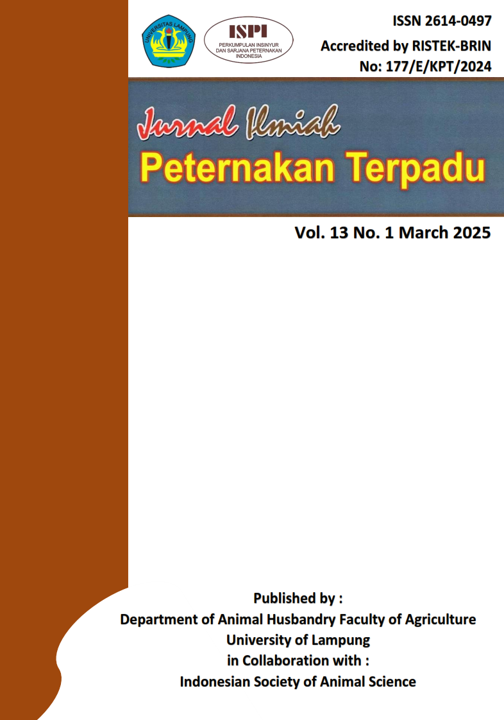The Influence of Trichocompost and NPK Fertilizer Combination on Productivity and Quality of Pakchong Grass
DOI:
https://doi.org/10.23960/jipt.v13i1.p32-42 Abstract View: 237
Abstract View: 237
Keywords:
NPK Fertilizer, Pakchong Grass, Productivity, TrichocompostAbstract
This research aims to determine effect of applying a combination of trichocompost fertilizer and NPK fertilizer with different levels on the productivity of Pakchong grass. This research was conducted from October to December 2023 at the Integrated Field Laboratory Greenhouse, Faculty of Agriculture, University of Lampung. This study used a factorial completely randomized design (CRD) consisting of trichocompost and NPK fertilizer factors. The trichocompost fertilizer factor consisted of 4 treatment levels, namely T0: without trichocompost (control), T1: 15 tons/ha of trichocompost fertilizer, T2: 30 tons/ha of trichocompost fertilizer, and T3: 45 tons/ha of trichocompost and the NPK fertilizer factor consists of 4 treatment levels, namely K0: no NPK fertilizer (control), K1: 100 kg/ha urea + 50 kg/ha TSP + 50 kg/ha KCL, K2: 150 kg/ha urea + 75 kg/ha TSP + 75 kg/ha KCL, and K3: 200 kg/ha urea + 100 kg/ha TSP + 100 kg/ha KCL. The data obtained were analyzed using Analysis of Variance (ANOVA) and followed by the Least Significant Difference (LSD). The results showed that the combination of trichocompost and NPK fertilizer did not give a significant interaction (P>0.05) on the number of tillers, fresh weight and dry matter of pakchong grass, but had a significant effect (P<0.05) on fresh weight and dry matter of pakchong grass crown. The results of the LSD test on fresh weight and dry matter of pakchong grass showed that T3 trichocompost fertilizer treatment gave the best results when compared to other treatments. The results showed that the use of NPK fertilizer had a significant effect (P<0.05) on the crude protein content and crude fiber content of pakchog grass. The results of the LSD test on crude protein showed that K3 treatment provides the best results compared to other treatments. While the crude fiber content of K3 treatment was significantly different from K1.
Downloads
References
Abror, M., and M.T. Fuadi. 2022. Effect nutrient "n" dose on growth and protein content of Napier Pakchong Grass and Zanzibar Napier Grass. Nabatia, 10(1): 45−55.
Adiningsih, J.S. 1992. Peranan Efisiensi Penggunaan Pupuk Untuk Melestarikan Swasembada Pangan. Orasi Pengukuhan Ahli Peneliti Utama. Jakarta.
Kaya, E. 2013. Pengaruh kompos jerami dan pupuk NPK terhadap N−tersedia tanah serapan N, pertumbuhan, dan hasil padi sawah (Oryza sativa L). Agrologia. 2(1): 43−50.
Kusuma M.E., Kastalani, Kristina. 2019. Efektifitas Pemberian Kompos Trichoderma terhadap Pertumbuhan dan Produksi Rumput Brachiaria humidicola di Lahan Gambut. Ziraa’ah. 44(1): 20–27.
Moersidi, S., J. Prawirasumantri, W. Hartatik, A. Pramudia, dan M. Sudjadi. 1990. Evaluasi kedua keperluan fosfat pada lahan sawah intensifikasi di Jawa. Prosiding Lokakarya Nasional Efisiensi Penggunaan Pupuk V. Cisarua 12−13 Nopember 1990. Pusat Penelitian Tanah. Bogor.
Nasution, E. 2009. Aplikasi Beberapa Tandan Kosong Kelapa Sawit Terhadap Pertumbuhan Bibit Jarak (Jathropa curcas). Universitas Riau. Pekanbaru.
Nurjannah, A. M. Jacoeb, Hidayat, Taufik, dan C. Rudy. 2018. Perubahan komponen serat Rumput Laut (Caulerpa Sp.) dari Tual, Maluku akibat proses perebusan. Jurnal Ilmu dan Teknologi Kelautan Tropis. 10(1): 35−48.
Pelealu, Johanis J., dan, E.L. Baideng. 2018. Sosialisasi penggunaan trichokompos di Desa Poopo Tengah dan Poopo Utara. Jurnal LPPM Bidang Sains dan Teknologi. 5(2): 96-102.
Rochayati, R., Mulyadi, dan J.S. Adiningsih. 1990. Penelitian efisiensi penggunaan pupuk di lahan sawah. Prosiding Lokakarya Nasional Efisiensi Penggunaan Pupuk V. Pusat Penelitian Tanah dan Agroklimat. Bogor.
Sastriana, E. 2016. Pengaruh Dosis Pupuk N (Nitrogen) Terhadap Kandungan Protein Kasar dan Serat Kasar Rumput Gajah cv. mott pada Tanah Regosol. Doctoral dissertation. Fakultas Peternakan Universitas Mataram. Mataram.
Suwahyo, U. 2009. Cara Membuat dan Petunjuk Penggunaan Biopestisida. Penebar Swadaya. Jakarta.
Suwahyono. 2003.Trichoderma harzianum Indigeneous untuk Pengendalian Hayati. Universitas Gadjah Mada. Yogyakarta.
Downloads
Published
How to Cite
Issue
Section
License

Jurnal Ilmiah Peternakan Terpadu(JIPT) is licensed under a Creative Commons Attribution 4.0 International License.
Authors who publish with this journal agree to the following terms:
- Authors retain copyright and grant the journal right of first publication with the work simultaneously licensed under a Creative Commons Attribution License that allows others to share the work with an acknowledgement of the work's authorship and initial publication in this journal.
- Authors are able to enter into separate, additional contractual arrangements for the non-exclusive distribution of the journal's published version of the work (e.g., post it to an institutional repository or publish it in a book), with an acknowledgement of its initial publication in this journal.
- Authors are permitted and encouraged to post their work online (e.g., in institutional repositories or on their website) prior to and during the submission process, as it can lead to productive exchanges, as well as earlier and greater citation of published work (See The Effect of Open Access).





















